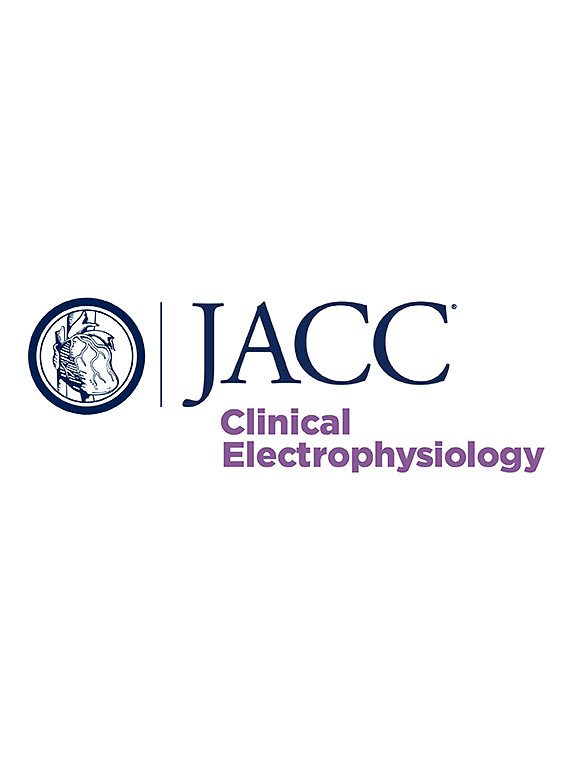Identification of Critical Slowing of Conduction Using Unipolar Atrial Voltage and Fractionation Mapping
IF 8
1区 医学
Q1 CARDIAC & CARDIOVASCULAR SYSTEMS
引用次数: 0
Abstract
Background
Ablation strategies targeting fractionated or low-voltage potentials have been widely used in patients with persistent types of atrial fibrillation (AF). However, recent studies have questioned their role in effectively representing sites of conduction slowing, and thus arrhythmogenic substrates.
Objectives
The authors studied the relationship between local conduction velocity (CV) and the occurrence of fractionated and/or low-voltage potentials in order to identify areas with critically slowing of conduction.
Methods
Intraoperative epicardial mapping was performed during sinus rhythm. Unipolar potentials with an amplitude <1.0 mV were initially classified as low-voltage and potentials with ≥3 deflections as fractionation. A range of thresholds were also explored. Local CV was computed using discrete velocity vectors.
Results
A total of 319 patients were included. Fractionated, low-voltage potentials were rare, accounting for only 0.36% (Q1-Q3: 0.15%-0.78%) of all atrial sites. Local CV at sites with fractionated, low-voltage potentials (46.0 cm/s [Q1-Q3: 22.6-72.7 cm/s]) was lowest compared with sites with either low-voltage, nonfractionated potentials (64.5 cm/s [Q1-Q3: 34.8-99.4 cm/s]) or fractionated, high-voltage potentials (65.9 cm/s [Q1-Q3: 41.7-92.8 cm/s]; P < 0.001). Slow conduction areas (CV <50 cm/s) could be most accurately identified by using a low voltage threshold (<1 mV) and a minimum of 3 deflections (positive predictive value: 54.2%-70.7%), although the overall sensitivity remained low (0.1%-1.9%).
Conclusions
Sites with fractionated, low-voltage potentials have substantially slower local CV compared with sites with either low-voltage, nonfractionated potentials or fractionated, high-voltage potentials. However, the strong inverse relationship between the positive predictive value and sensitivity of a combined voltage and fractionation threshold for slowed conduction is likely to complicate the use of these signal-based ablation approaches in AF patients.
利用单极心房电压和分频绘图确定传导的临界减慢。
背景:针对分馏电位或低电压电位的消融策略已广泛应用于持续性房颤(AF)患者。然而,最近的研究对其在有效代表传导减慢部位,从而代表致心律失常基质方面的作用提出了质疑:作者研究了局部传导速度(CV)与分化电位和/或低电压电位发生之间的关系,以确定传导严重减慢的区域:方法: 在窦性心律时进行术中心外膜测图。结果:共纳入 319 名患者:共纳入 319 名患者。分馏低电压电位很少见,仅占所有心房部位的 0.36%(Q1-Q3:0.15%-0.78%)。与低电压、非分馏电位(64.5 cm/s [Q1-Q3:34.8-99.4 cm/s])或分馏、高电压电位(65.9 cm/s [Q1-Q3:41.7-92.8 cm/s];P <0.001)的部位相比,分馏、低电压电位部位的局部 CV 最低(46.0 cm/s [Q1-Q3:22.6-72.7 cm/s])。慢速传导区(CV 结论:与低电压、非分馏电位或分馏、高电压电位的部位相比,分馏、低电压电位的部位的局部 CV 明显较慢。然而,电压和分馏阈值对传导减慢的阳性预测值和敏感性之间的强烈反比关系可能会使这些基于信号的消融方法在房颤患者中的应用复杂化。
本文章由计算机程序翻译,如有差异,请以英文原文为准。
求助全文
约1分钟内获得全文
求助全文
来源期刊

JACC. Clinical electrophysiology
CARDIAC & CARDIOVASCULAR SYSTEMS-
CiteScore
10.30
自引率
5.70%
发文量
250
期刊介绍:
JACC: Clinical Electrophysiology is one of a family of specialist journals launched by the renowned Journal of the American College of Cardiology (JACC). It encompasses all aspects of the epidemiology, pathogenesis, diagnosis and treatment of cardiac arrhythmias. Submissions of original research and state-of-the-art reviews from cardiology, cardiovascular surgery, neurology, outcomes research, and related fields are encouraged. Experimental and preclinical work that directly relates to diagnostic or therapeutic interventions are also encouraged. In general, case reports will not be considered for publication.
 求助内容:
求助内容: 应助结果提醒方式:
应助结果提醒方式:


